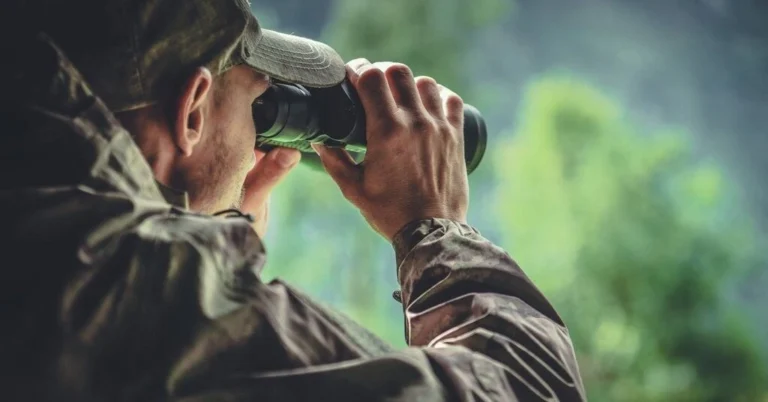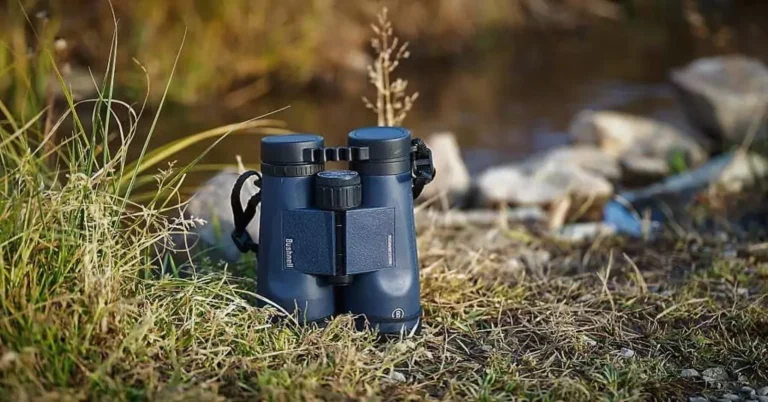Best Astronomy Binoculars in 2024
Welcome to the hobby of stargazing. This may be the only thing that we have in common. We love astronomy with all our hearts and want to capture every moment ourselves. We all know that the moment when we are stargazing is always astonishing. This feeling is not described in words When we look at the sky and explore the tremendous beauty of the universe. For this experience, we need a tool to look deeper into the sky. That is a binocular. We are here to describe the best binoculars in 2024. This is the best option if you are a newbie with a low budget. With binoculars, you can see objects that are barely visible through your naked eye, and it is straightforward to use because you can see a wide area of the sky at once.
How We Select Astronomy Binoculars for You
We love binoculars for astronomy because they have the specifications we need for stargazing. Unlike ordinary binoculars, they offer higher magnification and larger lens sizes to capture the beauty of the sky. We need stable binoculars for astrophotography that can hold still and produce clear images. Some binoculars are too heavy or expensive for our needs, so we have researched for you and found the best binoculars for astronomy. We have based our choices on optical quality, size and weight, eye relief, and build quality.
Review of the Top 5 Astronomy Binoculars in 2024
We recommend the top 5 astronomy binoculars. That is the highest in quality. Binoculars for astronomy will allow you to gaze up at the moon and deep space objects, check out planets, and more.
Here is the list of the best astronomical binoculars in 2024.
Best binoculars overall: Canon 12×36 IS III.
Canon 12×36 IS III is the overall best binoculars in 2024
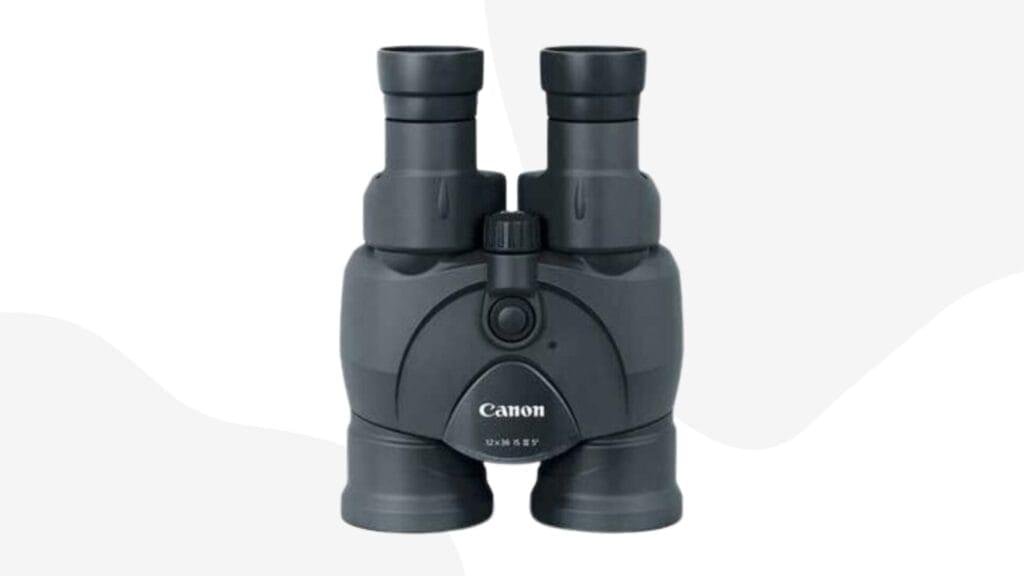
Specs
| Objective lens diameter | 36mm |
| Magnification | 12x |
| Field of view | 5 degrees |
| Eye relief | 0.57 inches (14mm) |
| Dimensions | 5 x 6.85 x 2.76 inches |
| Weight | 1.5 pounds |
Pros
- Effective stabilize the image
- Lightweight and compact
- Image stabilized
- Excellent optical quality
Cons
- Pricey
It will be no surprise why Canon 12×36 IS III binoculars are at the top of the list because they give the best-stabilized images. The binocular has high-end optics and Porro II prisms that provide a sharp, bright, colourful image, and the flattener produces a distortion-free image
We usually recommend a lens with a diameter greater than 36mm. However, this still gives the best shots for stargazing. You can also use this for another purpose, like bird watching. And due to the small lance, it is ideal for most people. Which is why it has earned the top position. It gives 12x magnification to see the moon’s surface
Canon built these with the same technology as the ones used in EF lenses. That is the reason it makes sharper images.
Best splurge: Canon 10×42 L IS WP
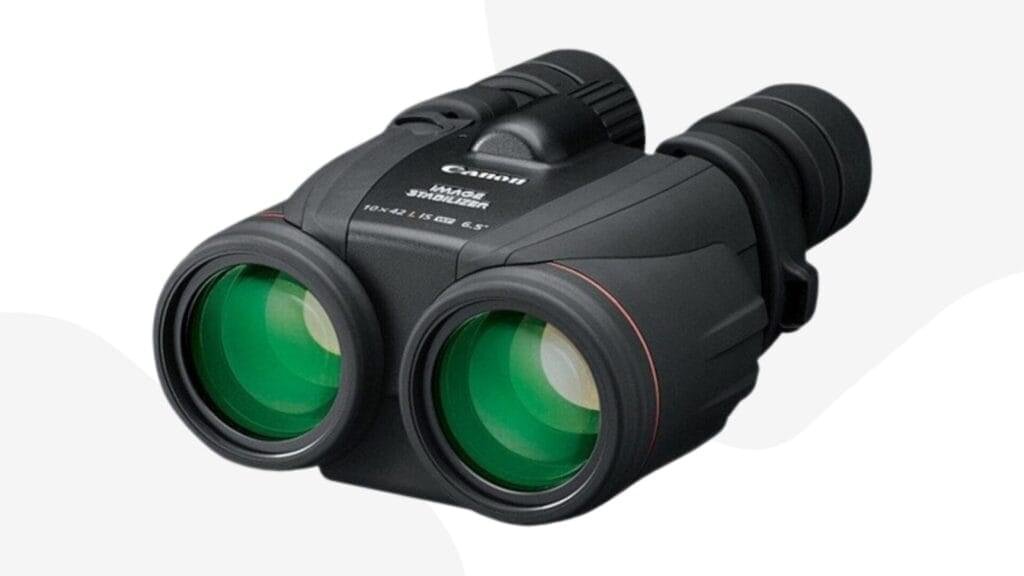
Specs
| Objective lens diameter | 42mm |
| Magnification | 10x |
| Field of view | 6.5 degree |
| Eye relief | 0.63 inches (16mm) |
| Weight | 2.4 pounds |
| Dimensions | 5.4 x 6.9 x 3.4 inches |
Pros
- Excellent stabilization
- High-quality optics
- Rugged build
- Plenty of eye relief
Cons
- Expensive
- Fairly heavy and bulky
If you have a high budget and want the best binoculars, then the Canon 10×42 L IS WP binoculars are made for you. The binocular with a power 43mm large objective lens captures light for dim celestial objects. The magnification of 10x is relatively best for astronomical observation.
The best feature of canons lens is that it gives impressive stabilized images. It feels like you are using a tripod. When you see the sharp and clear view of this. The symbol L in the name refers to the canon’s top-tier line of optics. The ultralow dispersion (UD) lenses on each side effectively correct the aberration. Images will be sharp and bright and present fabulized star views.
There are some disadvantages to these binoculars. First, it is too expensive. Everyone can’t afford it second, it is heavy and bulky to carry for a long time, but if you are serious, it is best binoculars that you need.
Best high power: Celestron Skymaster 25X100
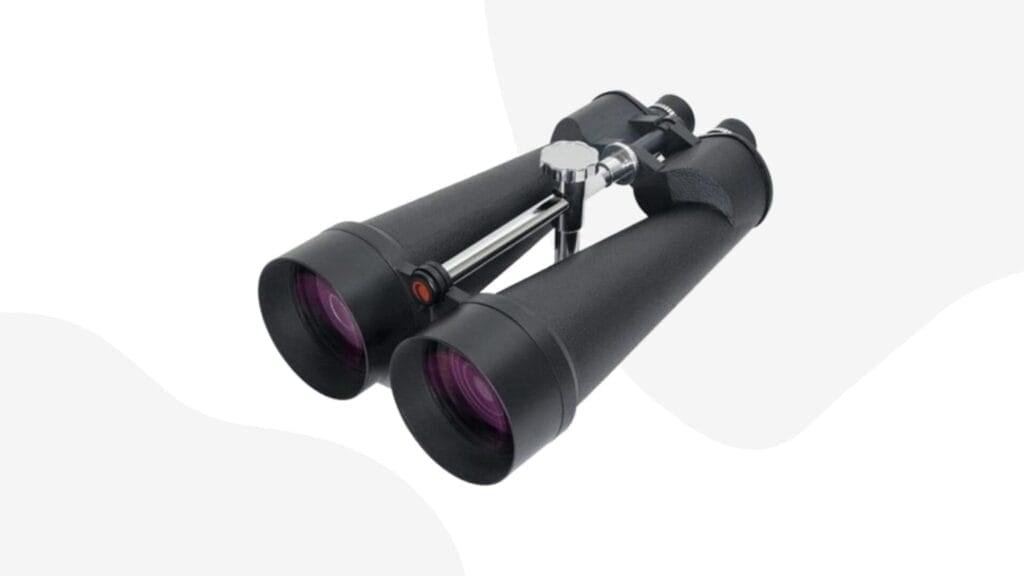
Specs
| Objective lens diameter | 100mm |
| Magnification | 25x |
| Field of view | 3 degrees |
| Eye relief | 0.59 inches (15mm) |
| Weight | 8.75 pounds |
| Dimensions | 10.1 x 5.1 x 15.28 inches |
Pros
- Giant object lens gathers tons of light
- Comes with a tripod adapter
- High magnification
- Waterproof
- Excellent image quality
Cons
- Not for handholding
- Very bulky
- Heavy
The Celestron is one of the best telescope generators. So, it is evident that they make the best binoculars for astronomy. Celestron Skymaster 25×100 looks like a hand-sized telescope. It offers 25x magnification power and a 100mm lens. This giant lens will let in tons of light. You can see epic detail in the night sky with high magnification, such as Jupiter’s belts, stars, clusters, and much more.
They are water resistant and come with rubber armored housing, which provides a hand grip and protects them from damage. These feature BaK4 prisms and multicoated lenses, enhancing contrast for viewing quality.
The Celestron SkyMaster 25X100 has a lot of weight, 8. 75 pounds, and is more significant than other binoculars on our list. It comes without any image stabilization. You can’t hold it by hand for a long time, but luckily, it comes with a tripod adaptor. You can attach a tripod with it. Making it more accessible to hook up to a tripod for handsfree use
Best Compact: Nikon PROSTAFF P7 10×42
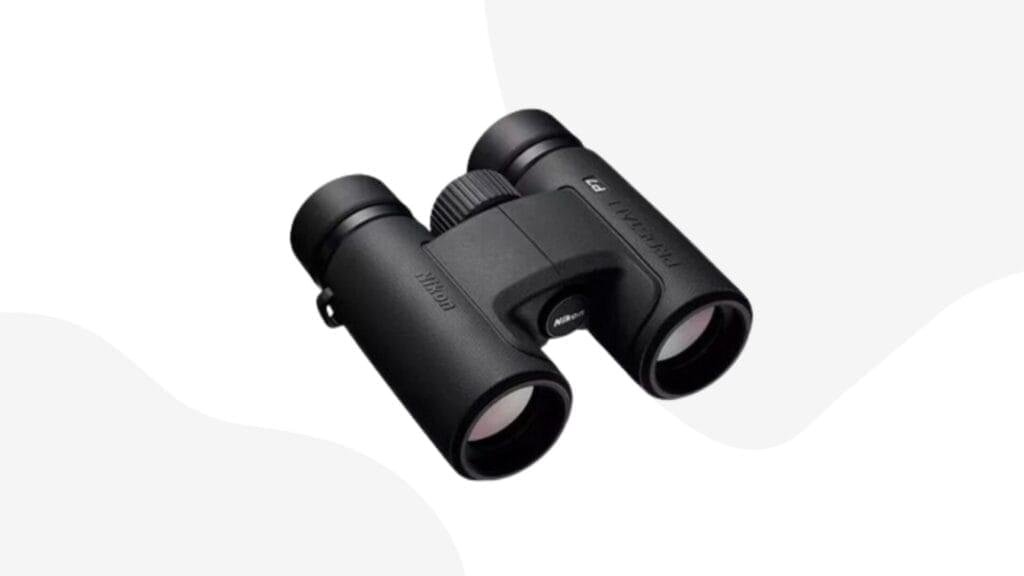
Specs
| Objective lens diameter | 42mm |
| Magnification | 10x |
| Field of view | 7 degrees |
| Eye relief | 0.62 inches (15.7mm) |
| Weight | 1.3 pounds |
| Dimensions | 5.91 x 5.12 x 2.17 inches |
Pros
- Lightweight and compact
- Waterproof
- Fog proof
- Long eye relief
- Versatile
Cons
- No tripod adapter
When selecting binoculars, it’s essential to take the weight into account. Because it is difficult to carry when hiking to explore dark skies. Then Nikon PROSTAFF P7 binoculars come into play. These are lightweight, weighing just 1.3 pounds and six inches long. It is easy to take it with you on a trip.
The PROSTAFF P7 are made for this. They are waterproof to 3.3 feet and nitrogen-filled for fog proof. The 0.62-inch eye relief is well for those who wear glasses, and the turn and slide eyecups are adjustable. A rubber armour protects them from damage and is easier to grip. Nikon used water and oil repellent on all lenses, which helped keep them fingerprint-free.
Unfortunately, these are not made explicitly for astronomy, but they will do their job. The 10x magnification is enough for a typical night sky. To maximize light transmission. It also features a dielectric high reflective multilayer prism coating.
Best budget: Celestron Up Close G2 10×50
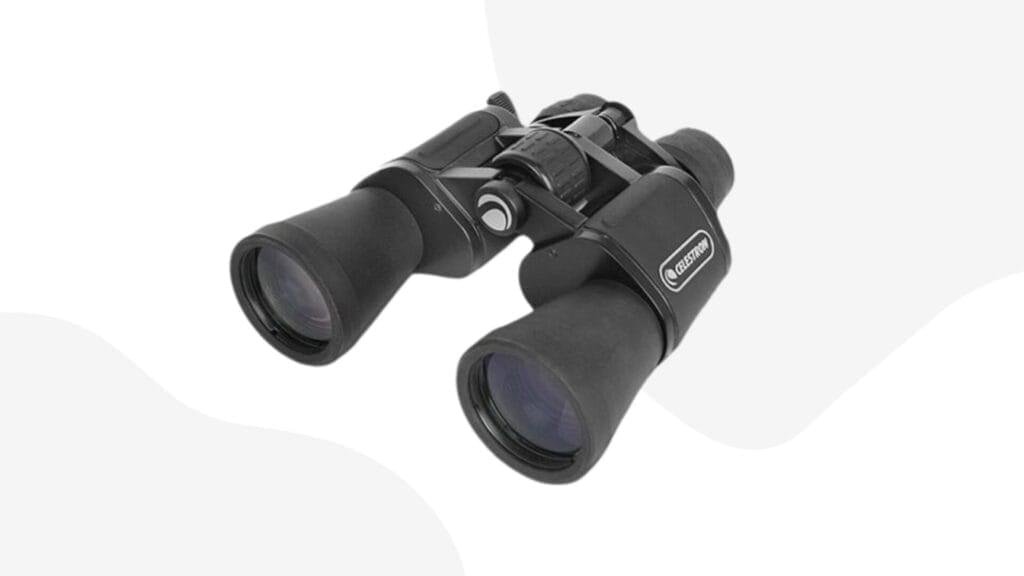
Specs
| Objective lens diameter | 50mm |
| Magnification | 10x |
| Field of view | 6.8 degrees |
| Eye relief | 0.47 inches (12mm) |
| Weight | 1.69 pounds |
| Dimensions | 8 x 7 x 2.5 inches |
Pros
- Very affordable
- Rubber coating for grip
- Water-resistant
- Good optical quality
Cons
- Requires collimation
- Not nitrogen-filled
- No fog proof
You don’t need to spend too much time selecting binoculars for astronomy inexpensive pairs, which are great for stargazing.it is lightweight, which makes it ideal, but it also offers 10x magnification and a 50 mm lens size. That allows you to see the moon, its beauty, and some star clusters.
Celestron designs these with a rubber coating that protects them from damage and is easier to hold. If you have these in the rain, don’t panic because They are water-resistant. They are not fog-filled, so they are not fogproof.
Celestron uses multicoating optics that give a sharp and high-contrast view. The list above is great if you are a newbie or want smoked-friendly or astronomy.
Factors to Consider When Buying Astronomy Binoculars
Aperture Size
The size of front lenses is responsible for light let in, but they also make the binoculars heavier and more complex to carry. For stargazing, you want lenses between 40 mm and 70 mm wide.
Magnification
The zoom-in feature of binos is magnification. More zoom means more details but also makes the view dimmer and the binoculars shakier. For stargazing, you need binoculars that zoom between 7x and 10x
Field of View
The area you can view through binoculars is a field of view. A broader view helps you find and follow the stars but also lowers the zoom and exit pupil. For stargazing, you need a view at least 5° wide.
Exit Pupil
It shows how much light reaches your eyes, which affects how bright and contrasted the stars look. To measure the exit pupil, divide the aperture by the magnification. It would help to have an exit pupil between 4 mm and 7 mm wide for stargazing.
Roofs vs Porros (Prism Type)
The type of prism that flips the images right side up. Roof prisms are sleek and compact but pricey and complicated. Porro prisms are bulky and angular but cheaper and more straightforward. Both can give you great images, but Porro prisms may be brighter and deeper.
Coating and Prisms
The material layer reduces the glare and scatter of light, which helps show sharp images. The coating is responsible for the quality of pictures and the higher price. For stargazing, you need at least multicoated lenses and prisms.
Size and Weight
More extensive and heavier binoculars may perform well but are more challenging to hold and transport. Smaller and lighter binoculars are more convenient but compromise on some features and quality. For stargazing, you need around 800 g to 1.5 kg binoculars.
Waterproof and Fog proof
For stargazing, you need waterproof and fogproof binoculars, or at least water-resistant and fog-resistant. Waterproof binoculars have a sealed body, while fogproof binoculars have a gas filling that prevents fogging. These features are helpful for outdoor use.
Eye Relief
How far the eyepiece is from your eye affects your comfort if you wear glasses. A more extended eye relief lets you see the whole view without pressing your eye against the eyepiece, while a shorter eye relief may require you to take off your glasses or adjust your position.
Durability and Build Quality
How solid and reliable the binoculars are affects how long they last and how well they work. Solid and well-built binoculars can handle shocks, drops, and wear and tear, while weak and poorly built binoculars may break or malfunction easily. For stargazing, you want binoculars made of sturdy and high-quality materials, such as metal, rubber, and glass, and with a solid and ergonomic design.
Stabilization Features
How the binoculars reduce the blur caused by hand movements and vibrations. Some binoculars have built-in stabilization features, such as gyroscopes, sensors, or motors, that adjust the lenses or prisms. These features make the image sharper and steadier but add size, weight, and price. For stargazing, you want binoculars with stabilization features or use a tripod or a mount.
Conclusion
In this blog, we explain the top five best astronomical binoculars. How to select binoculars for stargazing. Specs of astronomical binoculars. We are telling you about the most crucial build quality. Lastly, we deeply explained the essential factors of binoculars you need to consider before purchasing.
FAQS
Are astronomy binoculars better than telescopes for beginners?
Binocular wins when it comes to ease, affordability, and versatility. However, telescopes offer higher magnification and the potential for more detailed observations, making them suitable for those with specific interests in astronomy. Ultimately, both tools have advantages, and the optimal decision varies depending on one’s preferences and priorities.”
Can astronomy binoculars be used for daytime viewing?
Yes, we can use these binoculars to view objects in the daytime. Astronomical binocular has large objective lenses. That is capable of gathering tons of light. And improve image quality in low light. However, these features make them suitable for daytime.
What is the ideal aperture size for astronomy binoculars?
As we mentioned, the aperture size of astronomical binoculars commonly ranges between 40mm and 70mm. This range balances light-gathering ability and portability, making them well-suited for newbie stargazing.



